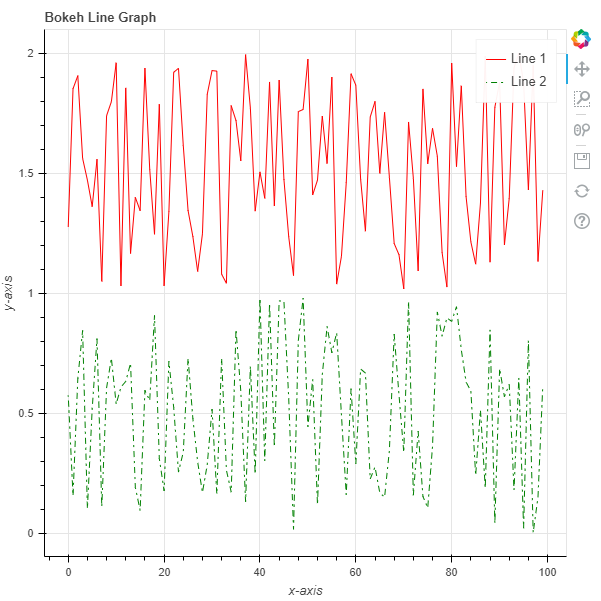Python Bokeh – 绘制折线图
Bokeh 是一个Python交互式数据可视化。它使用 HTML 和 JavaScript 渲染其绘图。它针对现代 Web 浏览器进行演示,提供具有高性能交互性的新颖图形的优雅、简洁构造。
Bokeh 可用于绘制折线图。可以使用plotting模块的line()方法绘制折线图。
plotting.figure.line()
Syntax : line(parameters)
Parameters :
- x : x-coordinates of the points to be plotted
- y : y-coordinates of the points to be plotted
- line_alpha : percentage value of line alpha, default is 1
- line_cap : value of line cap for the line, default is butt
- line_color : color of the line, default is black
- line_dash : value of line dash such as :
- solid
- dashed
- dotted
- dotdash
- dashdot
default is solid
- line_dash_offset : value of line dash offset, default is 0
- line_join : value of line join, default in bevel
- line_width : value of the width of the line, default is 1
- name : user-supplied name for the model
- tags : user-supplied values for this model
Other Parameters :
- alpha : sets all alpha keyword arguments at once
- color : sets all color keyword arguments at once
- legend_field : name of a column in the data source that should be used
- legend_group : name of a column in the data source that should be used
- legend_label : labels the legend entry
- muted : determines whether the glyph should be rendered as muted or not, default is False
- name : optional user-supplied name to attach to the renderer
- source : user-supplied data source
- view : view for filtering the data source
- visible : determines whether the glyph should be rendered or not, default is True
- x_range_name : name of an extra range to use for mapping x-coordinates
- y_range_name : name of an extra range to use for mapping y-coordinates
- level : specifies the render level order for this glyph
Returns : an object of class GlyphRenderer
示例 1:在此示例中,我们将使用默认值来绘制图形。
# importing the modules
from bokeh.plotting import figure, output_file, show
# file to save the model
output_file("gfg.html")
# instantiating the figure object
graph = figure(title = "Bokeh Line Graph")
# the points to be plotted
x = [1, 2, 3, 4, 5]
y = [1, 6, 8, 2, 3]
# plotting the line graph
graph.line(x, y)
# displaying the model
show(graph)
输出 :  示例 2:在此示例中,我们将绘制一个带有虚线和其他参数的折线图。
示例 2:在此示例中,我们将绘制一个带有虚线和其他参数的折线图。
# importing the modules
from bokeh.plotting import figure, output_file, show
# file to save the model
output_file("gfg.html")
# instantiating the figure object
graph = figure(title = "Bokeh Line Graph")
# name of the x-axis
graph.xaxis.axis_label = "x-axis"
# name of the y-axis
graph.yaxis.axis_label = "y-axis"
# the points to be plotted
x = [1, 2, 3, 4, 5]
y = [5, 2, 1, 7, 1]
# color of the line
line_color = "red"
# type of line
line_dash = "dotted"
# offset of line dash
line_dash_offset = 1
# name of the legend
legend_label = "Sample Line"
# plotting the line graph for AAPL
graph.line(x, y,
line_color = line_color,
line_dash = line_dash,
line_dash_offset = line_dash_offset,
legend_label = legend_label)
# displaying the model
show(graph)
输出 :  示例 3:现在我们将了解如何在同一个图中绘制多条线。我们将使用
示例 3:现在我们将了解如何在同一个图中绘制多条线。我们将使用random()函数生成点。
# importing the modules
from bokeh.plotting import figure, output_file, show
import random
# file to save the model
output_file("gfg.html")
# instantiating the figure object
graph = figure(title = "Bokeh Line Graph")
# name of the x-axis
graph.xaxis.axis_label = "x-axis"
# name of the y-axis
graph.yaxis.axis_label = "y-axis"
# plotting line 1
# generating the points to be plotted
x = []
y = []
for i in range(100):
x.append(i)
for i in range(100):
y.append(1 + random.random())
# parameters of line 1
line_color = "red"
line_dash = "solid"
legend_label = "Line 1"
# plotting the line
graph.line(x, y,
line_color = line_color,
line_dash = line_dash,
legend_label = legend_label)
# plotting line 2
# generating the points to be plotted
x = []
y = []
for i in range(100):
x.append(i)
for i in range(100):
y.append(random.random())
# parameters of line 2
line_color = "green"
line_dash = "dotdash"
line_dash_offset = 1
legend_label = "Line 2"
# plotting the line
graph.line(x, y,
line_color = line_color,
line_dash = line_dash,
line_dash_offset = line_dash_offset,
legend_label = legend_label)
# displaying the model
show(graph)
输出 : 